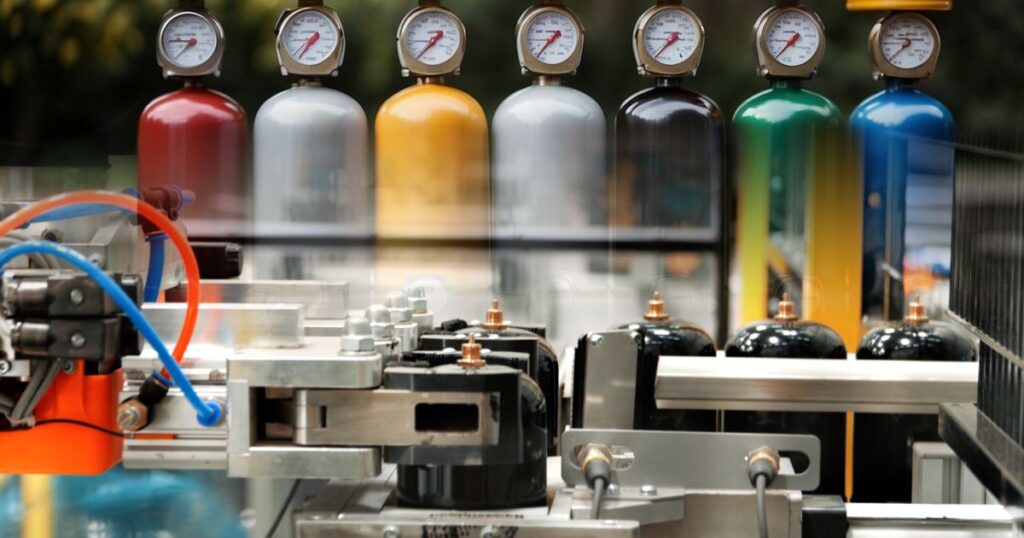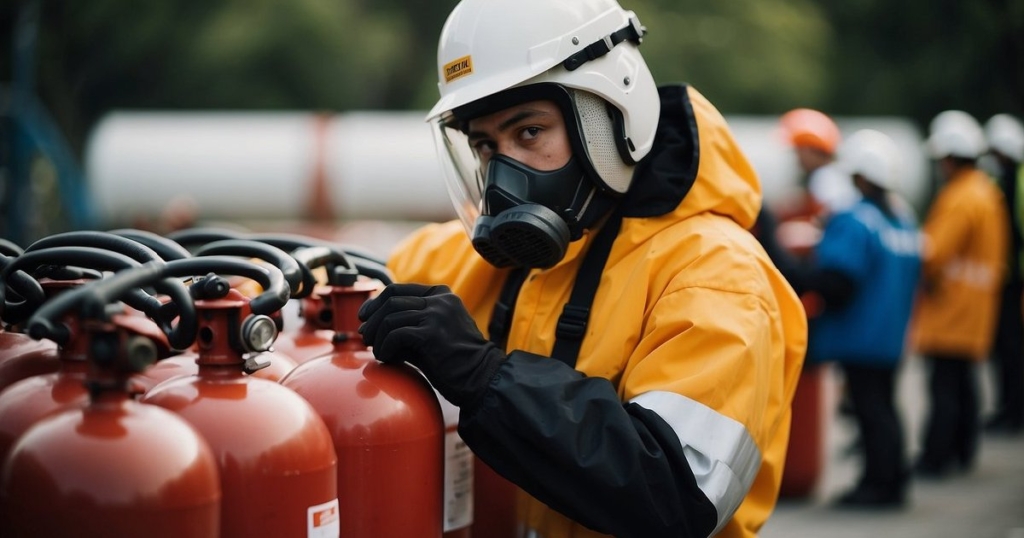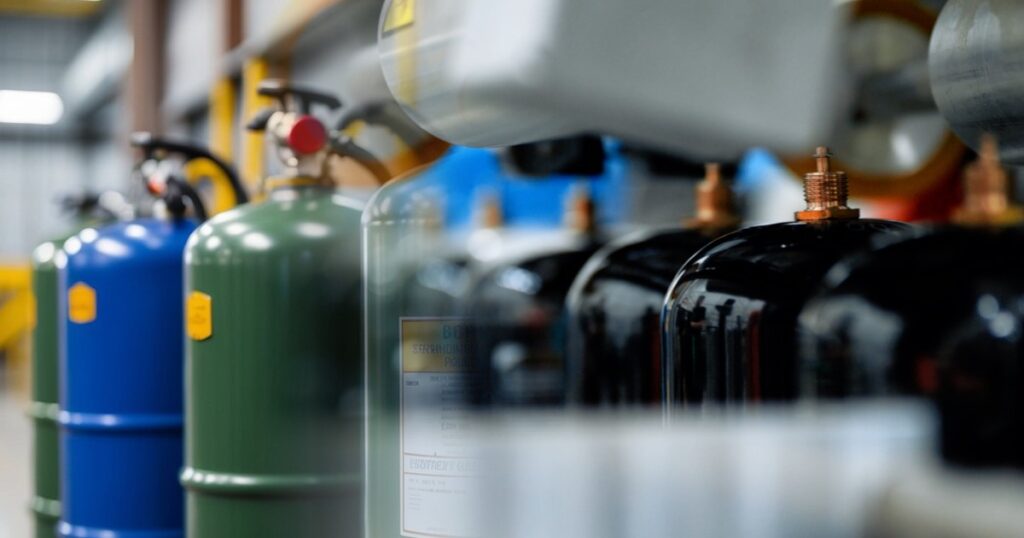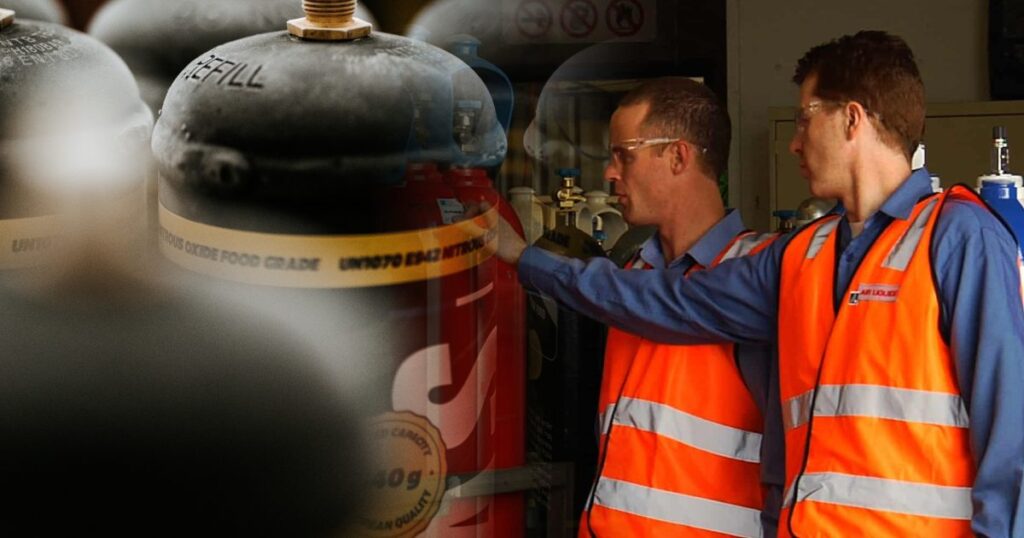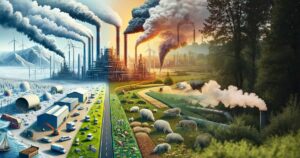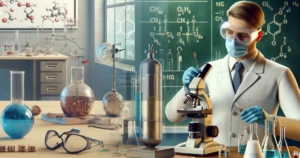Gas Cylinder Guide: Essential Safety Tips and Usage Overview
FastGas Blog
Gas cylinders are indispensable tools in various industries, from medical to manufacturing, providing a convenient way to transport and store gases under pressure. These cylinders come in different sizes and types, each specifically designed to contain gases such as oxygen, nitrogen, or carbon dioxide, catering to various applications ranging from welding to refrigeration. Recognising the properties and types of gas cylinders is crucial for selecting the right one for your needs, ensuring the efficient and safe execution of your projects. This gas cylinder guide will help you gain knowledge.
Safety and handling guidelines are of paramount importance when dealing with pressurised gas cylinders. The necessity for proper storage, transportation, and usage practices cannot be overstated, as they are fundamental to preventing accidents and maintaining workplace safety. Complying with regulatory standards, understanding the colour codes for different gases, and adhering to maintenance and inspection schedules are all essential aspects of gas cylinder management. Armed with the right knowledge, you can confidently navigate the complexities of gas cylinder usage.
Key Takeaways
- Understanding different types using this gas cylinder guide ensures proper selection for specific applications.
- Following safety guidelines mitigates risks involved in handling pressurised cylinders.
- Regular maintenance and adherence to standards are critical for cylinder longevity and safety.
Types and Properties of Gas Cylinders
When you select a gas cylinder, it’s crucial to understand the types available and their specific properties. Knowing the differences ensures safe and appropriate use for various applications.
Classification by Contents
Gas cylinders can be classified based on the type of gas they contain, which determines their use and the associated safety measures. Here is a list of common gases and their categories:
- Flammable Gases: These include gases like propane and acetylene, which can ignite easily.
- Inert Gases: Such as argon and helium, they are non-reactive and do not burn.
- Liquefied Gases: Gases like anhydrous ammonia and chlorine are pressurised and cooled into liquid form.
- Non-Liquefied Gases: Compressed gases like oxygen and nitrogen that remain gaseous under pressure.
- Dissolved Gases: Acetylene is a common gas dissolved in a solvent within the cylinder.
- Toxic Gases: These gases, like chlorine, are harmful if inhaled or come in contact with skin.
- Corrosive Gases: Such as anhydrous ammonia, can damage materials they come into contact with.
Material and Design Specifications
The materials and designs of gas cylinders cater to the specific needs of the gases intended to hold. Here’s an overview:
- Fiber Composite Cylinders: Offer high strength, are lightweight, and are used for gases like helium.
- Steel Cylinders: Typically used for a wide range of gases, including oxygen and carbon dioxide.
- Plastic Liners: Often used with fibre composite cylinders to store gases such as chlorine and argon.
The design specifications include aspects like cylinder specification, date of manufacture, serial number, and tare weight, ensuring that the cylinder meets safety standards and is suitable for the particular gas it is designed to hold.
Safety and Handling Guidelines
Ensuring safety while handling gas cylinders requires adherence to strict guidelines. Your awareness of these procedures protects you and others from potential hazards.
General Handling Procedures
When handling gas cylinders, such as the Fast-Gas range suitable for varied applications, you need to be aware of the risks involved and follow certain procedures:
- Inspect cylinders for leaks, damage, or corrosion before use.
- Secure cylinders during handling to prevent them from falling.
- Use appropriate manual handling techniques to move cylinders, considering their weight and size.
- Wear protective clothing, including safety shoes and gloves, to protect against potential hazards.
Connecting and Disconnecting Cylinders
Proper connection and disconnection of gas cylinders are critical to prevent leaks and other dangers:
- Ensure all tools and equipment, such as high-pressure hoses, are in good condition before connecting them.
- Check that the cylinder and the equipment are compatible.
- Follow the manufacturer’s guidelines for the correct fitting of the cylinder.
- Always perform a leak test after connecting the cylinder.
Storage and Transportation
Storing and transporting gas cylinders requires special attention to avoid accidents and comply with regulations:
- Store cylinders in a well-ventilated area, away from sources of ignition.
- When storing cylinders indoors, maintain them in an upright position and secure them to prevent tipping.
- Transport cylinders using appropriate vehicles that can handle the load securely.
- Comply with OSHA regulations and guidelines for storing and transporting flammable and explosive materials.
Remember, only trained individuals should handle gas cylinders to ensure the necessary safety precautions and emergency procedures are understood and followed thoroughly.
Regulatory Compliance and Standards
When working with gas cylinders, your adherence to regulatory compliance and standards is critical to ensure safety and legal operations. Specific regulations govern the manufacturing, testing, storage, and transport to mitigate risks associated with these high-pressure containers.
Manufacturing and Testing Regulations
- OSHA and DOT: You must ensure that gas cylinders are manufactured and tested according to strict standards set by organisations like the Occupational Safety and Health Administration (OSHA) and the Department of Transportation (DOT). These regulations encompass the design, material selection, and construction specifics, including the cylinder valve and labelling.
- Cylinder Label and Markings: Each cylinder should have a legible label identifying the gas contents, with clear hazard warnings. The label must also feature the cylinder serial number, retest markings, and the cylinder manufacturer’s inspection marking to trace its history and integrity.
- Medical Gas Cylinders: If you are dealing with medical gas cylinders, you need a Manufacturer’s Authorization as part of compliance to ensure the product is suitable for medical use.
Storage and Transport Regulations
- Correct Storage: Gas cylinders must be stored upright, secured, and in well-ventilated areas, away from sources of heat and ignition. Tanks should also have a visible cylinder label to ensure correct identification and handling measures.
- Manual Handling Regulations: The movement of cylinders should comply with Manual Handling Regulations to minimise the risk of injury. This includes using appropriate equipment, such as cylinder trolleys, and ensuring employees are trained in safe manual handling techniques.
- Transportation: When transporting cylinders, whether it’s a Fast-Gas range for specific applications or any other type, DOT and ICC (if applicable) guidelines govern how and where tanks can be moved. These rules stipulate how cylinders should be secured in vehicles, the properties of gases that can be transported together, and the presence of appropriate hazard placards.
Maintenance and Inspection
Maintaining and inspecting your gas cylinders is vital for safety and longevity. Regular checks ensure that your cylinders perform correctly and safely when handling Fast-Gas products, which are designed for various applications, from welding to medical uses.
Routine Inspection
You should inspect your gas cylinders routinely to detect potential issues that could lead to safety hazards. During inspection, take note of the following:
- Cylinder Label: Verify that the label is legible and intact. It contains critical information, including contents, pressure ratings, and safety instructions.
- Regulator: Ensure the regulator is free from damage and is functioning properly.
- Cylinder Valve: Check for leaks, corrosion, or damage.
- Storage Area: Your cylinders should be stored upright in a cool, dry area, away from direct sunlight and heat sources.
- Best Practices:
- Always use a trolley for transport to prevent dropping and damaging the cylinders.
- For an empty cylinder, follow appropriate disposal or return guidelines.
- Following the manufacturer’s instructions to avoid leaks and other hazards when connecting and disconnecting cylinders.
Maintenance extends your cylinders’ life cycle and ensures they are safe for use every time.
Cylinder Lifecycle Management
Proper lifecycle management of your gas cylinders ensures their longevity and safety. Here’s how you can manage the lifecycle effectively:
- Initial Inspection and Test: Cylinders must be inspected and tested by qualified personnel when manufactured.
- Periodic Inspection: Set frequencies are established for further mandatory inspections. The frequency of these tests should be in accordance with the regulatory requirements and the manufacturer’s guidelines.
- Refurbishment: Cylinder refurbishment should be carried out by trained individuals, including valve replacement, painting, and re-labelling.
- Final Disposal: When cylinders can no longer be safely used or refurbished, they must be disposed of properly, adhering to environmental regulations and safety standards.
Remember, gas cylinder safety is paramount, and maintenance, coupled with regular inspections, is the key to preventing accidents and ensuring that your Fast-Gas cylinders can serve their specific applications safely and reliably.
Frequently Asked Questions
Navigating the complexities of gas cylinders is crucial for safety and efficiency. This FAQ section provides targeted guidance on common concerns and regulations you should be aware of.
What are the safety guidelines for storing gas cylinders in the workplace?
You should store cylinders in a well-ventilated area, secured upright, and away from sources of heat or ignition. Periodic checks are essential to ensure a safe working environment.
How do you determine the appropriate type of gas cylinder for a specific use?
Select a cylinder by matching its gas type to your application’s needs. FastGas cylinders, for example, offer a wide range of specific applications, from domestic use to industrial.
What is the proper method for risk assessment on gas cylinder storage?
Performing a risk assessment involves identifying potential hazards, evaluating the risks, and implementing measures to mitigate them, such as securing cylinders and restricting access to authorised personnel.
How can you interpret the labels and markings on a gas cylinder?
Labels and markings on a gas cylinder include the product name, hazard warnings, and handling instructions. The weight indication can also be found, often on a silver disc at the top, denoting the empty weight.
What is the capacity of a standard domestic LPG cylinder?
A standard domestic LPG cylinder typically has a capacity of about 13 to 15 kilograms, sufficient for average household cooking and heating needs.
What are the regulations for the manual handling of gas cylinders?
Manual handling regulations require that anyone changing or handling gas cylinders be fully trained and use appropriate personal protective equipment like gloves and safety footwear.
